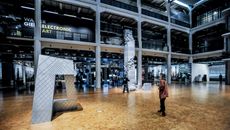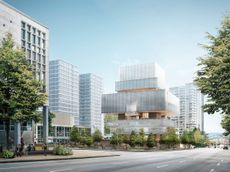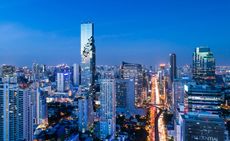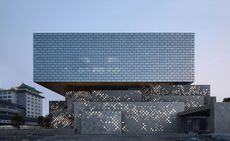Ole Scheeren on how architecture ‘is a celebration of life’ at Brainstorm Design 2018
- (opens in new tab)
- (opens in new tab)
- (opens in new tab)
- Sign up to our newsletter Newsletter
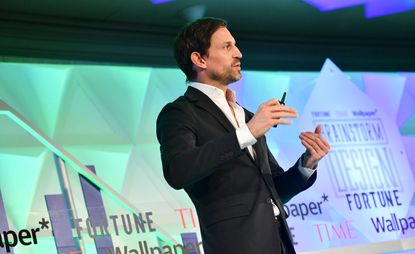
Great works of architecture can transform the way we experience and shape the world, says architect Ole Scheeren (opens in new tab). Over the past decade, Scheeren has transformed skylines all over Asia with landmark buildings including the conjoined towers of Beijing’s CCTV Headquarters, the Jenga block-like forms of Singapore’s Interlace (opens in new tab), and the pixelated skyscraper that is Bangkok’s MahaNakhon (a set of terraced towers for Ho Chi Minh City is in the works (opens in new tab)).
Returning to Singapore, Scheeren took the stage at the Brainstorm Design conference (opens in new tab) to discuss the power of architecture. Buildings, in his view, should not only be functional and economically viable, but also facilitate cultural exchange and enrich public life.
Singapore is a case in point. The city-state ‘embodies some of the issues that many Asian, and indeed global cities face today,’ he said. ‘As population density increases, the predominant typologies that define urban spaces are towers. Many of them stand in no relation to each other. I want to reestablish context and define a world in which we live in relation to each other.’
About a kilometre away from the conference venue (the Mandarin Oriental on Raffles Avenue) is his latest Singapore project, Duo (opens in new tab), built on land between what he called ‘two completely unrelated buildings.’ The solution? Forming a circular swoop with the twin towers to embrace a plaza that ‘adds to the public life of the city itself, creating a civic nexus for a previously isolated part of the city.’ The concave façades channel the winds, creating microclimates in the courtyards to create more liveable spaces.

Ole Scheeren addresses the Brainstorm Design conference (opens in new tab) in Singapore on 6 March 2018.
With the Interlace, Scheeren avoided towers altogether, instead stacking horizontal structures to create a complex form. ‘From the outside it evades logic, but inside there is a precise system of courtyards and gardens, spaces that enhance the diversity of life,’ he said.
He also used greenery everywhere. ‘If we add the amount of greenery left on the site, plus the gardens we created on the roof, we get 112 per cent of the greenery that the strip of land would otherwise accommodate.’ At the 2015 World Architecture Festival, Interlace was named World Building of the Year. ‘It recognises that Asia is able to set new standards in what is possible in the world today,’ says Scheeren.
More recently, Scheeren unveiled the Guardian Art Centre (opens in new tab), a layered structure in stone, glass and steel adjacent to Beijing’s Forbidden City. Scheeren found a typology that didn’t disrupt the dense, low-slung alleys in the neighborhood.
‘My idea was a base that would be in extension of the small scale of the city. I would put smaller cubes on the site and flow a single volume of glass on top.’ The cubes harmoniously blend in with the existing structures, while the 1700 sq m, column-free space above opens up all sorts of possibilities for exhibitions, auctions and other forms of public activity.
‘It’s a celebration of life in all the hybrid forms in which it exists. History can be an important part of how we build the future,’ says Scheeren.
The Brainstorm Design conference is jointly organised by Fortune, TIME and Wallpaper*, bringing together more than 300 top speakers and delegates from 33 countries. See more here
INFORMATION
For more information, visit the Brainstorm design website (opens in new tab)
TF has been editor of Wallpaper* since December 2020. He is responsible for our monthly print magazine, planning, commissioning, editing and writing long-lead content across all our content pillars. He also plays a leading role in multi-channel editorial franchises, such as our annual Design Awards, Guest Editor takeovers and Next Generation series. He aims to create world-class, visually-driven content while championing diversity, international representation and social impact. TF joined Wallpaper* as an intern in January 2013, and served as its commissioning editor from 2017-20, winning a 30 under 30 New Talent Award from the Professional Publishers’ Association. Born and raised in Hong Kong, he holds an undergraduate degree in history from Princeton University.
-
 Men’s engagement rings for modern grooms
Men’s engagement rings for modern groomsMen’s engagement rings, whether classic or colourful, make for sentimental tokens
By Hannah Silver • Published
-
 Longchamp unites with D’heygere on a playful collection made to ‘transform the everyday’
Longchamp unites with D’heygere on a playful collection made to ‘transform the everyday’Inspired by Longchamp’s foldaway ‘Le Pliage’ bag, this collaboration with Paris-based jewellery and accessories designer Stéphanie D’heygere sees pieces that ‘transform and adapt’ to their wearer
By Jack Moss • Published
-
 Last chance to see: Marc Newson’s all-blue designs in Athens
Last chance to see: Marc Newson’s all-blue designs in AthensGagosian gallery Athens presents new blue furniture and objects by Marc Newson
By Rosa Bertoli • Published
-
 ‘Ole Scheeren: Spaces of Life’ celebrates ‘form follows fiction’ in architecture
‘Ole Scheeren: Spaces of Life’ celebrates ‘form follows fiction’ in architecture‘Ole Scheeren: Spaces of Life’, a comprehensive look into the work of the German architect, opens at ZKM | Center for Art and Media Karlsruhe
By Ellie Stathaki • Published
-
 Interiors for Ole Scheeren’s Fifteen Fifteen in Vancouver revealed
Interiors for Ole Scheeren’s Fifteen Fifteen in Vancouver revealedFifteen Fifteen, a high-end, high-rise residential development by Ole Scheeren in Vancouver, Canada, reveals its apartment interiors ahead of sales launch
By Ellie Stathaki • Last updated
-
 Scale meets ambition in Vancouver’s architectural future
Scale meets ambition in Vancouver’s architectural futureThe latest instalment in our ‘Letter from...' series journeys through the urban future of Canada's ‘most liveable city’
By Hadani Ditmars • Last updated
-
 Büro Ole Scheeren’s MahaNakhon tower in Bangkok launches with floating glass sky deck
Büro Ole Scheeren’s MahaNakhon tower in Bangkok launches with floating glass sky deckBy Harriet Thorpe • Last updated
-
 Ole Scheeren reveals design for Barclay Village in Vancouver
Ole Scheeren reveals design for Barclay Village in VancouverBy Harriet Thorpe • Last updated
-
 WeWork’s Miguel McKelvey says design is all about connecting people
WeWork’s Miguel McKelvey says design is all about connecting peopleBy Robert Horn • Last updated
-
 Büro Ole Scheeren adds DUO high rise complex to Singapore skyline
Büro Ole Scheeren adds DUO high rise complex to Singapore skylineBy Daven Wu • Last updated
-
 Büro Ole Scheeren’s Guardian Art Center completes in Beijing
Büro Ole Scheeren’s Guardian Art Center completes in BeijingBy Harriet Thorpe • Last updated



